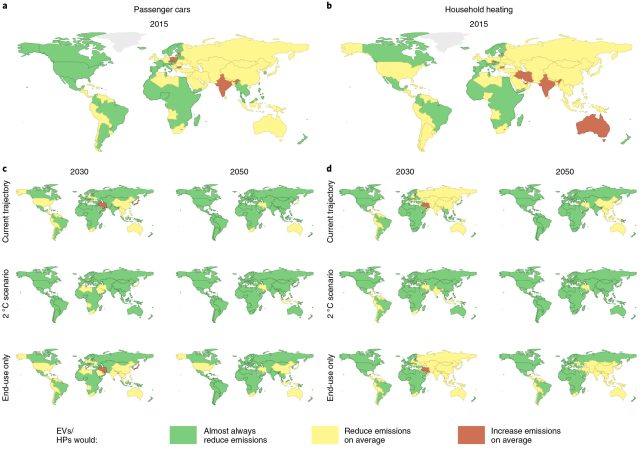
One peppy slogan for the energy revolution is to “electrify everything”—to replace fossil fuel applications with electrical devices that can be powered by a clean grid. Of course, most grids are nowhere close to emissions-free, and this can complicate the impact of electrification. With the electricity available to you, is it definitely the case that any electric car, for example, will produce fewer emissions than an efficient gas-powered vehicle?
While that question can be frustrating for a consumer, it could be even thornier for policymakers. If grids have to get cleaner for the “electrify everything” strategy to be beneficial, programs encouraging things like EVs might not have the intended effect. To provide clearer answers to this question, a team led by Florian Knobloch at Radboud University did the math to find out how green EVs and heat pumps for home heating are in different countries.
Pump up the heat
If you’re not familiar, heat pumps work on the same basic principle as an air conditioner—using refrigerant coils to dump heat from one side to the other. But instead of just dumping heat from your house into the outside air like an air conditioner does, these can also run in the other direction, dumping heat energy from the outside air (or ground) into your home—even at low outside temperatures. This process is extremely energy-efficient, even compared to high-efficiency gas furnaces.
The researchers separated the world into 59 regions, using data on the power plants running their grids as well as the types of vehicles and home-heating methods in use. Then they used estimates for the total life cycle emissions (which include manufacturing as well as operation) of the available range of electric vehicles and heat pumps. This was plugged into a detailed economic model that simulated realistic uptake of these technologies from 2015 to 2050, using several distinct scenarios.
The first scenario simply sees a continuation of current trends. The grid only gets 16 percent cleaner by 2050, in terms of emissions per kilowatt-hour of electricity. Electric vehicles grow modestly to about 19 percent of road transportation miles, and heat pumps hit 16 percent of home heating demand. The second scenario represents strong emissions-reductions policies, pushing EVs up to half of road miles, heat pumps up to over a third of home heating, and making the grid 74 percent cleaner. A third scenario is a combination of the first two—strong policies boosting EV and heat-pump use but no policies to clean up the grid. That tests whether “electrify everything” could backfire.
The results show that circumstances in which EVs or heat pumps increase emissions are rare, even today. The average break point is around 1,000 grams of CO2 per kilowatt-hour of electricity, which is roughly the efficiency of the oldest and dirtiest coal plants. As long as your grid is slightly cleaner than that, EVs and heat pumps should reduce emissions. So for 53 of the 59 regions analyzed—representing about 95 percent of road transportation and home heating—it’s already true that replacing with EVs or heat pumps is beneficial.
Some exceptions allowed
There’s a wide range of outcomes here. Compare, for example, Switzerland’s exceptionally low-carbon grid to Estonia’s, which runs primarily on oil shale. Swapping an internal combustion vehicle for an electric one in Switzerland cuts emissions by 70 percent, and a heat pump will cut them by about 88 percent. But in Estonia, an EV would increase emissions by 40 percent and a heat pump pushes that to an eye-watering 120 percent.
A more significant exception can be found in Japan. In the scenarios with little progress on grid emissions, a decade from now, the combination of Japan’s dirtier grid and preference for hybrid vehicles means that swapping in EVs doesn’t quite pay.

But averaged over the globe, EVs already represent about a 31-percent emissions savings per kilometer, and heat pumps are a 35-percent savings per unit heating. Even in the scenario where these technologies are promoted but the grid isn’t cleaned up much, there’s a substantial benefit through 2050. And that’s obviously larger in the scenario where policies also reduce grid emissions more. Total vehicle emissions are reduced about 30 percent in this scenario, and home heating emissions drop about 45 percent.
The model assumes continued progress on efficiency for fossil-fuel-powered cars and furnaces as well as their electric counterparts, but the emissions of fuel-burning machines are mostly unavoidable. Electric vehicles and heat pumps, meanwhile, are already cleaner (unless you live in Estonia) and can improve further as the grid improves.
As time goes on, emissions from manufacturing electric vehicles accounts for a larger share of their total life cycle emissions, the researchers note. You can make the vehicle efficient and the grid clean, but you’ll also have to clean up industry to keep shrinking that carbon footprint.
Nature Sustainability, 2020. DOI: 10.1038/s41893-020-0488-7 (About DOIs).
reader comments
173